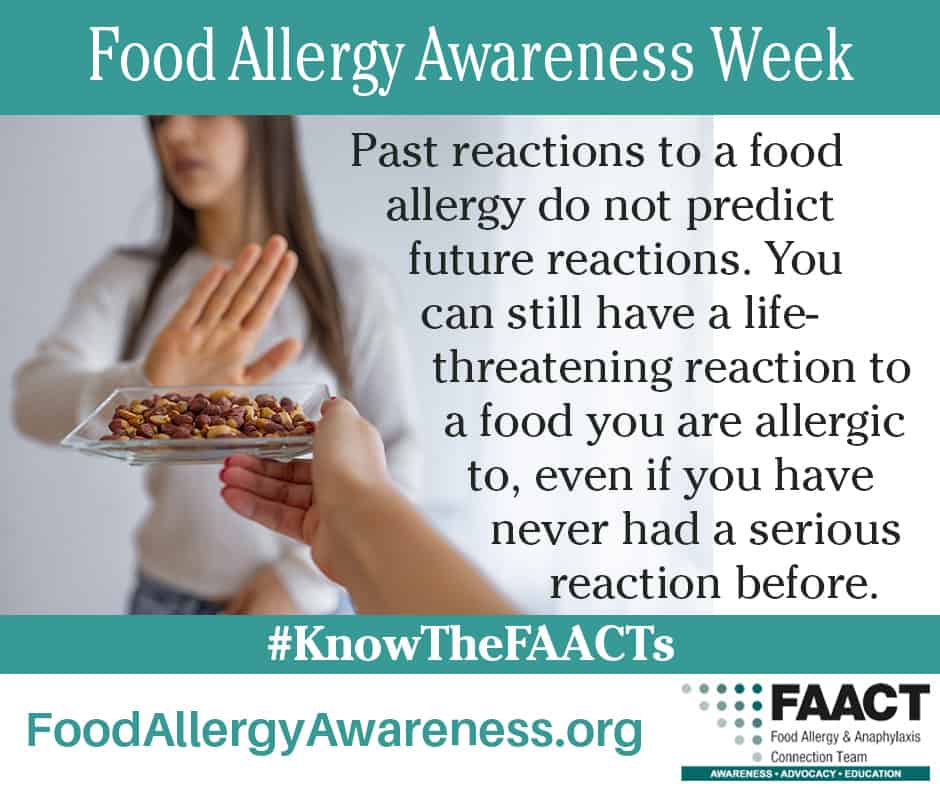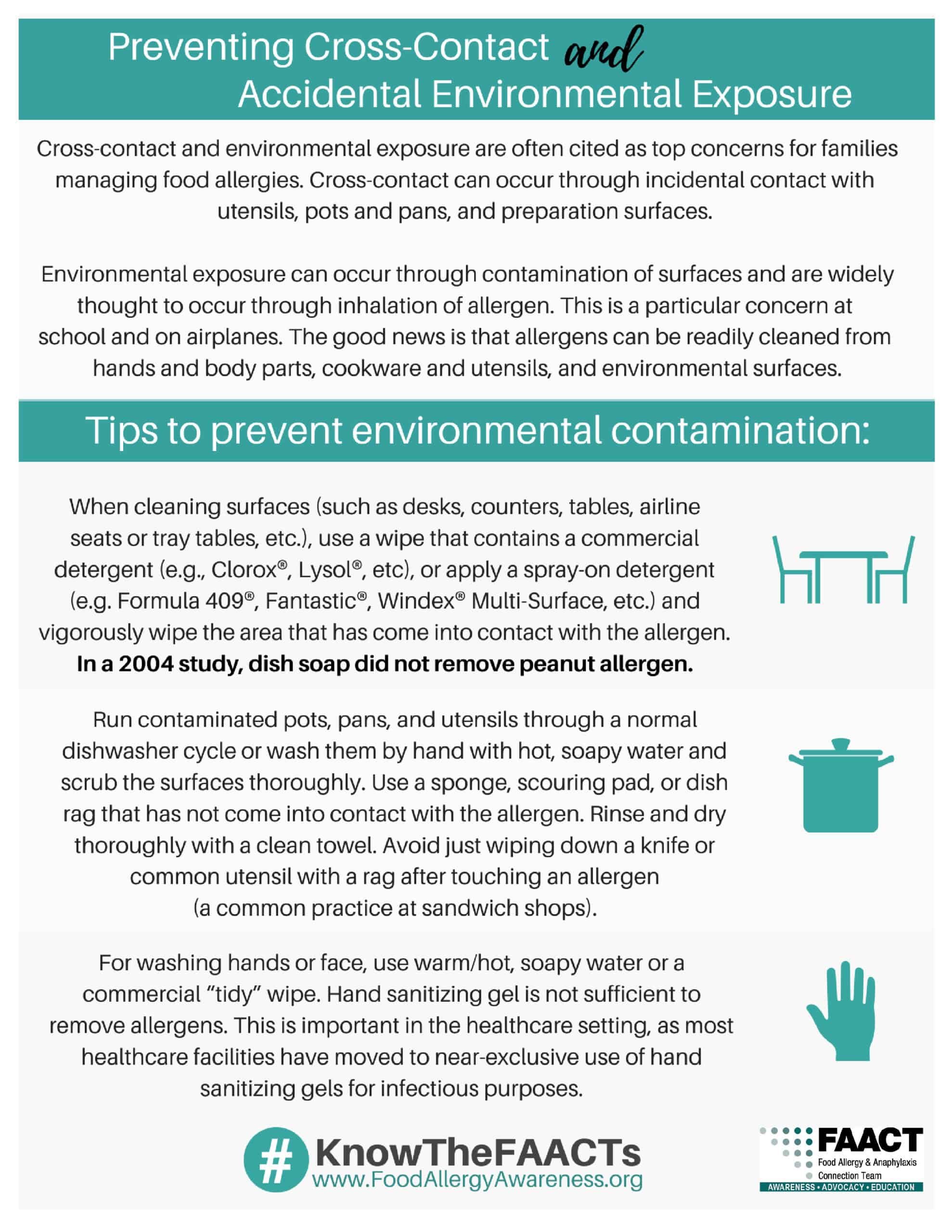Don’t Eat That: The Major Food Allergens (Including #9)

Did you know that May is Food Allergy Awareness Action month? This week (May 9-15, 2021) is also #foodallergyawarenessweek.
Food allergies affect as many as 32 million Americans, including 26 million adults and 5.6 million children. Managing a food allergy involves constant vigilance. In order to avoid food allergy reactions, first, we need to look at which particular foods cause the most reactions and ultimately how to manage reactions if they occur.
The 8 Major Food Allergens
When I was in grade school, the number of food allergies among my peers was practically non-existent. Over the years more food allergies have made “the list.” The Food Allergen Labeling and Consumer Protection Act of 2004 (FALCPA), identified the following eight foods as major food allergens:
- Milk
- Eggs
- Fish
- Shellfish
- Tree nuts
- Peanuts
- Wheat
- Soybeans
The U.S. Department of Health & Human Services says “at the time of the law’s [FALCPA] passage, these eight major allergens accounted for 90 percent of food allergies and serious allergic reactions in the U.S.”
Say it isn’t so! Unfortunately, FARE (Food Allergy Research & Education) says a person can be allergic to virtually any food. Learn more about less common allergens.
And Another One…
Sesame has recently been added to the list and will be required to be labeled a major food allergen on packaging starting January 1, 2023. The addition of sesame and the allergen labeling enforcement comes from President Biden under the FASTER Act of 2021. FASTER is an acronym for Food Allergy Safety, Treatment, Education, and Research.
Diagnosis and Testing
How do you know if you have a food allergy? FARE advises if you suspect that you may have food allergies do not diagnose a food allergy on your own. Self-diagnosis can lead to unnecessary dietary restrictions and inadequate nutrition, especially in children. In these cases, always contact a qualified medical professional to be properly evaluated, diagnosed, and treated.
Food Allergy Reactions
Symptoms of food allergies typically appear from within a few minutes to a few hours after a person has eaten the food to which he or she is allergic. A severe, life-threatening allergic reaction is called anaphylaxis.
Each year in the U.S., 200,000 people require emergency medical care for allergic reactions to food.
FARE | Food Allergy Research & Education
The most common type of allergic reaction to food is known as an IgE-mediated food allergy.
Symptoms include:
- tingling or itching in the mouth
- a raised, itchy red rash (hives) – in some cases, the skin can turn red and itchy, but without a raised rash
- swelling of the face, mouth, throat or other areas of the body
- difficulty swallowing
- wheezing or shortness of breath
- feeling dizzy and lightheaded
- feeling sick (nausea) or vomiting
- abdominal pain or diarrhea
- hay fever-like symptoms, such as sneezing or itchy eyes
Note that some of these symptoms are not always due to a food allergen. If you have known food allergies and you are experiencing any of these symptoms while eating, stop eating the food immediately, evaluate the need to use emergency medication (such as epinephrine) and seek medical attention right away.

Anaphylaxis
Anaphylaxis is a medical emergency. Without quick treatment, it can be life-threatening. The symptoms can be sudden and get worse very quickly.
- swollen tongue
- breathing difficulties
- tight chest
- trouble swallowing or speaking
- feeling dizzy or faint
- collapse
If you or someone else is experiencing these symptoms call emergency services immediately.
Food Allergy Prevention Steps

Click here for ADDITIONAL tips on avoiding your food allergen.
Product Labeling
The Food and Drug Administration (FDA) enforces the provisions of FALCPA in most packaged food products and dietary supplements. Meat, poultry, and certain egg products are regulated by the U.S. Department of Agriculture. As for alcoholic beverages, their enforcement on labeling allergens is subject to Alcohol and Tobacco Tax and Trade Bureau labeling regulations.
FDA guidance for the food industry includes that advisory statements should not be used as a substitute for adhering to safe manufacturing practices and the label advisories must be truthful – not misleading.
Reporting Adverse Reactions and Labeling Concerns
The FDA urges if you or a family member has had an allergic reaction after eating an FDA-regulated food or food product with unclear labeling or a possible undeclared allergen, discuss this with your health care provider. Keep any food packages because they may contain important information.
Report the suspected reaction or labeling concerns to the FDA in one of these ways:
- Consumers and manufacturers can submit reports detailing product reactions or other complaints to an FDA Consumer Complaint Coordinator for the state where the food was purchased. View a list of FDA Consumer Complaint Coordinators.
- For non-meat food products (cereals, fish, produce, fruit juice, pasta, cheeses, etc.), call the FDA at 1-888-SAFEFOOD (1-888-723-3366).
- For meat, poultry, and egg products, call the USDA Meat and Poultry Hotline at 1-888-MPHotline (1-888-674-6854).
- Submit a report using FDA’s MedWatch Online reporting form for consumers.
Preventative Steps for the Food Industry
Don’t wait for an outbreak, recall, worse – a life-threatening reaction to occur due to improper labeling, handling, or preparing of food. TapRooT® Root Cause Analysis provides a systematic framework to support the food and beverage industry to safely manufacture and deliver safe/high-quality food to consumers worldwide. Our proactive approach works by preventing outbreaks and recalls, and keeping people safe.
TapRooT® helps food and beverage companies get to the root causes of food safety issues and improve industrial safety in the production facilities.
Find Out More About TapRooT® Root Cause Analysis
TapRooT® Root Cause Analysis is the world’s leading systematic root cause analysis process, training, and software to analyze and fix problem’s real root causes across multiple industries. Here are five additional sources for information about the TapRooT® System.
- A paper that describes how to use the TapRooT® Root Cause Analysis System – CLICK HERE
- A paper about the 7 Secrets of Root Cause Analysis
- The TapRooT® Executive Portal
- TapRooT® Root Cause Analysis Training
- Upcoming Public TapRooT® Courses and Webinars



